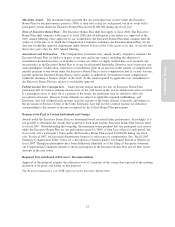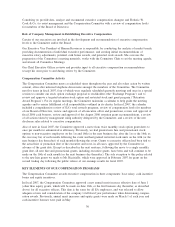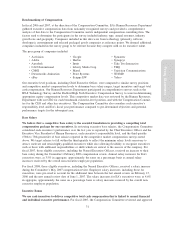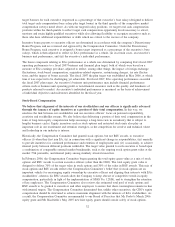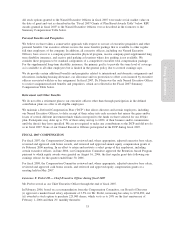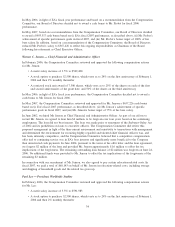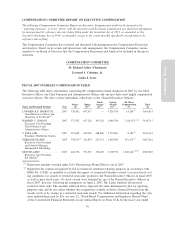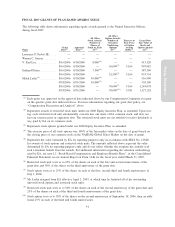Electronic Arts 2007 Annual Report Download - page 43
Download and view the complete annual report
Please find page 43 of the 2007 Electronic Arts annual report below. You can navigate through the pages in the report by either clicking on the pages listed below, or by using the keyword search tool below to find specific information within the annual report.target bonuses for each executive (expressed as a percentage of that executive’s base salary) designed to deliver
total target cash compensation (base salary plus target bonus) in the third quartile of the competitive market
compensation surveys noted above. As with our targeted salary positions, we target total cash compensation
positions within the third quartile to reflect target cash compensation opportunity levels necessary to attract,
motivate and retain highly qualified executives while also allowing flexibility to recognize executives such as
those who have additional responsibilities or skills which are critical to the success of the company.
Incentive bonus payouts to executive officers are determined in accordance with the company’s Discretionary
Bonus Program, and are reviewed and approved by the Compensation Committee. Under the Discretionary
Bonus Program, each executive is assigned a bonus target (expressed as a percentage of the executive’s base
salary), which is then adjusted to reflect (i) EA’s performance as a whole, (ii) in certain cases, an executive’s
business unit performance, and (iii) the executive’s individual performance.
The bonus component relating to EA’s performance as a whole was determined by comparing EA’s fiscal 2007
operating performance to a fiscal 2007 business and financial plan target, both of which were based on a
measure of EA’s earnings per share, adjusted to reflect, among other things, the impact of foreign exchange
fluctuations, stock-based compensation, acquisition-related expenses, restructuring charges, tax rate fluctua-
tions, and the impact of bonus accruals. The fiscal 2007 the plan target was established in May 2006, at which
time it was expected to be challenging yet achievable. For fiscal 2007, EA’s operating performance exceeded
the fiscal 2007 plan target. An executive’s business unit performance may include financial performance
criteria such as business unit operating profit or non-financial measures such as the quality and timeliness of
products released to market. An executive’s individual performance is measured on the basis of achievement
of individual objectives and milestones identified for the fiscal year.
Stock-Based Compensation
We believe that alignment of the interests of our stockholders and our officers is significantly advanced
through the issuance of equity incentives as a portion of their total compensation. In this way, we
reinforce the link between our stockholders and our executive officers’ focus on personal responsibility,
creativity and stockholder returns. We also believe that delivering a portion of their total compensation in the
form of long-term equity compensation helps encourage a long-term view in an industry that is subject to
lengthy business cycles. Equity incentives such as stock options and restricted stock units also play an
important role in our recruitment and retention strategies, as the competition for creative and technical talent
and leadership in our industry is intense.
Historically, the Compensation Committee had granted stock options, but not RSU awards, to executive
officers (i) when they first join EA, (ii) in connection with a significant change in responsibilities, (iii) annually
to provide incentives for continued performance and retention of employment and, (iv) occasionally, to achieve
internal parity between different positions within EA. The target value granted to each executive is based upon
a combination of comparable external market benchmarks, such as the ongoing stock option grant value at the
market 75th percentile, and internal parity among similarly situated executives.
In February 2006, the Compensation Committee began granting the total equity grant value as a mix of stock
options and RSU awards to certain executive officers (other than the CEO). The total equity grant value is
designed to deliver 70% of the target value in stock options and 30% of the value in RSU awards. This mix of
stock options and RSU awards reflects the Compensation Committee’s belief that (i) stock options are an
important vehicle for encouraging equity ownership by executive officers and aligning their interests with EA’s
stockholders’, whereas (ii) RSU awards allow the Company to keep abreast of competitive trends in equity
compensation, particularly in light of the implementation of SFAS No. 123(R), and to strengthen the retention
of key employees. The Compensation Committee also reviews the estimated total pool of stock options and
RSU awards to be granted to executives and other employees to ensure that share consumption remains in line
with internal targets. The Compensation Committee determined that, unlike other executives, the CEO’s equity
compensation should be structured to achieve maximum alignment with the interests of EA’s stockholders. As
a result, the Compensation Committee recommended to our Board of Directors that Mr. Probst’s March 2006
equity grant and Mr. Riccitiello’s May 2007 new hire equity grants should consist solely of stock options.
32



